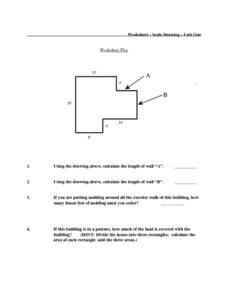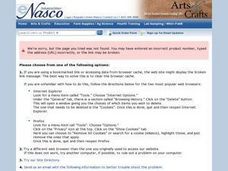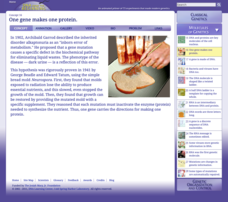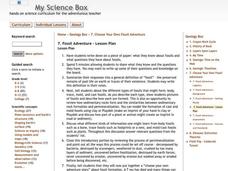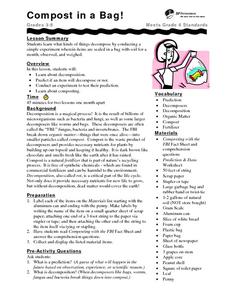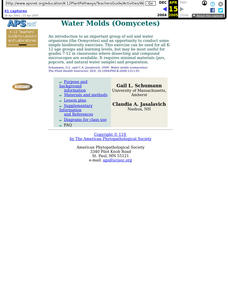Curated OER
The Magic School Bus In a Pickle
Students learn along with Ms. Frizzle's class. In this Magic School Bus lesson plan, students discover what microbes need to grow - and how cold affects microbe growth - by growing bread mold.
Curated OER
Making and Using a Gel Person to Teach Human Anatomy
Students investigate organs, anatomical planes and transverse sections of the human body using gel people. In this human anatomy lesson plan, students use gel molds, gel and food items to make models of the human body. They create a...
Curated OER
Melt and Pour Soap Recipes
Students are able to make many differnt kinds of soaps. They are told that they must purchase a pre-made melt and pour soap base from a craft supplier, melt it, add soap colorants and fragrances and otherr additives as you like and...
Curated OER
Worksheet Five
In this scale drawing worksheet, learners use the scale drawing of a building to calculate the length of two walls. They compute the amount of molding they must order (perimeter). Students calculate the area of the house to determine how...
Curated OER
Get to Know Glass
Students learn about the properties of glass. In this making and molding glass lesson, students participate in an experiment where they will learn how glass is created and how it is shaped to create bottles and jars. Students also...
Curated OER
A Walk in the Wild
Fifth graders identify characteristics of animals and their habitat. In this animal science lesson, 5th graders read Crinkleroot's Book of Animal Tracking and and Animal Tracks. Students match animal tracks to the correct animal...
Curated OER
Discovering the Forgotten Kingdom Protista
Protists, like algae and mold, are sometimes overlooked for classroom study, but they are astonishing in their diversity and importance.
Curated OER
DISCOUNT LENSES ( GELATIN WAVE GUIDES)
Students study attributes associated with concept of fiber optics is done using a labmade fiber optic from clear molded gelatin. A variety of shapes can be cut and pieced together to form a conduit to transmit the laser beam by internal...
Curated OER
Are Viruses Alive: Sample Socratic Questions
Students comprehend the definition and uniqueness of life and its complexities. They examine what characteristics constitute a living organism. Students recognize the extent of the role viruses play in the movement and molding of life as...
Curated OER
Crayon Shapes
Students create an Easter Basket stuffer. In this holiday art lesson, students melt crayons together over a small cooking pot and pour the melted crayons into a candy mold. Students let them dry and are able to color with the...
Curated OER
Nasco Color Sculpt Mask Making
Learners study the various masks made in African, Japanese, and Ancient Egyptian cultures and discuss the funtion of these masks in each society. They create a mask from one of these cultures using a molding technique.
Cold Spring Harbor Laboratory
One Gene Makes One Protein
Very few universities still offer a master's degree in the ecology of grasses, but that was the degree that led George Wells Beadle to an interest in genetics and later a Nobel Prize. Scholars learn about the discoveries of Dr. Beadle...
Cornell University
Bacteria Take Over and Down
Bacteria outnumber all other forms of life on Earth. Scholars observe the growth of bacteria in petri dishes to understand their role in maintaining good health. Then, they observe the growth of bacteria after they introduce...
Curated OER
Fossil Adventure
Students create a book about the process of a dinosaur becoming a fossil. For this earth science lesson, students are taught about fossils and create a book that tells what happened to a dinosaur's bones after they die.
Curated OER
Making Tracks
Students cast animal tracks on a field trip. They split up to capture tracks from different areas and use plaster of Paris to mold to the footprint. They bring casts back to class, create a negative mold and paint it black.
Curated OER
Word Scramble – Lesson 3
In this health activity, middle schoolers identify and define vocabulary terms related to foodborne illness. They unscramble the words listed at the bottom of the sheet and use them to complete each of 8 blanks.
Curated OER
Spud Smear
Young scholars study various samples of microorganisms in petri dishes. In this microorganism lesson, students place various samples of items in petri dishes and observe them after several days of incubation.
Curated OER
Recycle Lifecycle
Students investigate the recycling process. In this recycling lesson, students read the article The Recycling Process After Collection and discuss the advantages of recycling. As an extension activity, students simulate the molding of...
Curated OER
Naked to the Eye
Students understand that microorganisms are too small to see but there are other indications they exist. In this microorganisms lesson, students recognize that some microorganism are helpful and some are not. Students use a microscope to...
Curated OER
Leafy Gold Jewelry
Learners work together to collect a variety of leaves from their school grounds. Using clay, they shape it to form a mold of the leaf and paint it a gold color after it has dried. To end the lesson, they attach a string to make a necklace.
Education Outside
Compost in a Bag
Young scientists create a compost bag, predict changes, and after one month, examine the bag to observe the changes that have occurred.
Curated OER
Water Molds (Oomycetes)
Students research a group of fungus-like organisms; the Oomycetes, by baiting them from natural sources (water and soil) and observing them.
Curated OER
What's That Brown Fuzzy Stuff On My Plum?
Students examine Koch's Postulates by actually using them. They perform each of the required four steps to show that the brown fuzzy fungus they see growing on stone fruit (plums, peaches, nectarines, cherries) is what causes them to rot.
Curated OER
Diversity of Microorganisms
In this biology worksheet, students identify and locate various vocabulary terms related to the diversity of microorganisms from A to Z. There are 39 biology terms located in the word search.
Other popular searches
- Cast and Mold Fossils
- Bread Mold Experiment
- Bread Mold
- Moldy Bread Experiment
- Fungi and Mold
- Mold on Bread
- Mold Making
- Moldova
- Clay Molds
- Yeast Mold
- Fungus and Mold
- Fossil Molds



